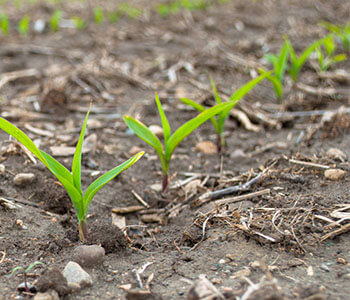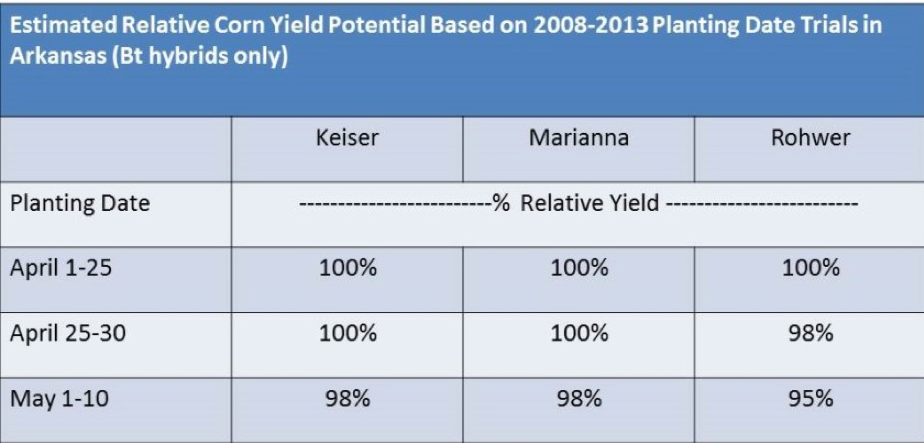Corn Planting Dates - How Late Can You Plant?
Mar 23, 2020

Corn Planting Date Information – Jeff Pangle , WinField United Technical Seed Agronomist for the Delta Region
The questions are starting to come – “how much longer can we plant corn and keep top yield potential?” At this point , we have not lost any yield potential yet in many geographies and would not expect to lose any yield potential on irrigated fields until late April in South Arkansas and early May as we go north in the Arkansas. Can we raise 200+ bu/acre corn planted in April , or early May?
Based on the research in the table below from Dr. Jason Kelley from The University of Arkansas , the answer is YES! We don’t have to look back very far to see a great example of this as the 2019 planting season was challenging as well. It goes without saying though that getting conducive weather during the growing season and implementing good management practices is needed to achieve high yields regardless of planting date.
The table below is a summary of corn planting date trials that were conducted from 2008-2013 showing estimated corn yield potential based on planting dates for Keiser (Northeast AR) , Marianna (East-Central AR) , and Rohwer (Southeast AR) using Bt traited hybrids.

Mississippi geographic references – Marianna would be a similar latitude to North MS (Clarksdale , Marks , Batesville etc.) Rowher would be a similar latitude to Central MS (Cleveland , Grenada , Greenville , Leland , etc.) *Although there are no testing locations south of Rowher in this trial , the interpolation could be made that for NE LA (Lake Providence , Mer Rouge , Tallulah , etc.) and the Yazoo River Basin (Hollandale , Rolling Fork , Belzoni , Yazoo City , etc.) up to mid-April , corn planting would still be an option.
With the introduction of Bt corn and above ground insect protection , we have dramatically extended the window of corn planting in the Delta. Prior to the Bt traited corn hybrids , I can remember walking conventional corn fields that were ravaged by corn borer when we planted corn late. It should be noted that Refuge (non-Bt) corn should be planted as soon as feasible.
The next question would be how much later is harvest going to be from an April planting than a March planting? Corn growth is driven by heat units and we typically accumulate heat units much more rapidly in April planted corn than from early or Mid-March plantings.
The table below is from a planting date trial at Marianna , AR , conducted in 2013 and shows the impact of planting date on silking date and maturity date. In this trial , April planted corn typically may only be delayed a week in maturity compared to corn that was planted several weeks earlier. This can vary year to year is based strictly on heat unit accumulation. Corn is a DD50 crop.

In conclusion , the weather pattern will change and we will plant corn. We still have plenty of time to get a corn crop planted and maintain maximum yield potential.
Excerpts and charts from an article on March 25 , 2015 by Jason Kelley , University of Arkansas Extension Agronomist
The questions are starting to come – “how much longer can we plant corn and keep top yield potential?” At this point , we have not lost any yield potential yet in many geographies and would not expect to lose any yield potential on irrigated fields until late April in South Arkansas and early May as we go north in the Arkansas. Can we raise 200+ bu/acre corn planted in April , or early May?
Based on the research in the table below from Dr. Jason Kelley from The University of Arkansas , the answer is YES! We don’t have to look back very far to see a great example of this as the 2019 planting season was challenging as well. It goes without saying though that getting conducive weather during the growing season and implementing good management practices is needed to achieve high yields regardless of planting date.
The table below is a summary of corn planting date trials that were conducted from 2008-2013 showing estimated corn yield potential based on planting dates for Keiser (Northeast AR) , Marianna (East-Central AR) , and Rohwer (Southeast AR) using Bt traited hybrids.

Mississippi geographic references – Marianna would be a similar latitude to North MS (Clarksdale , Marks , Batesville etc.) Rowher would be a similar latitude to Central MS (Cleveland , Grenada , Greenville , Leland , etc.) *Although there are no testing locations south of Rowher in this trial , the interpolation could be made that for NE LA (Lake Providence , Mer Rouge , Tallulah , etc.) and the Yazoo River Basin (Hollandale , Rolling Fork , Belzoni , Yazoo City , etc.) up to mid-April , corn planting would still be an option.
With the introduction of Bt corn and above ground insect protection , we have dramatically extended the window of corn planting in the Delta. Prior to the Bt traited corn hybrids , I can remember walking conventional corn fields that were ravaged by corn borer when we planted corn late. It should be noted that Refuge (non-Bt) corn should be planted as soon as feasible.
The next question would be how much later is harvest going to be from an April planting than a March planting? Corn growth is driven by heat units and we typically accumulate heat units much more rapidly in April planted corn than from early or Mid-March plantings.
The table below is from a planting date trial at Marianna , AR , conducted in 2013 and shows the impact of planting date on silking date and maturity date. In this trial , April planted corn typically may only be delayed a week in maturity compared to corn that was planted several weeks earlier. This can vary year to year is based strictly on heat unit accumulation. Corn is a DD50 crop.

In conclusion , the weather pattern will change and we will plant corn. We still have plenty of time to get a corn crop planted and maintain maximum yield potential.
Excerpts and charts from an article on March 25 , 2015 by Jason Kelley , University of Arkansas Extension Agronomist